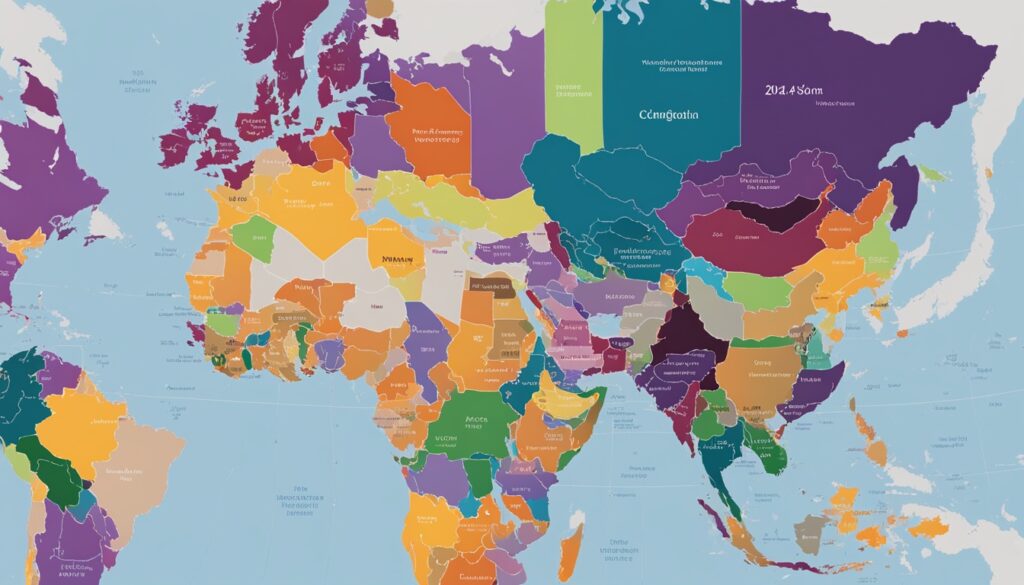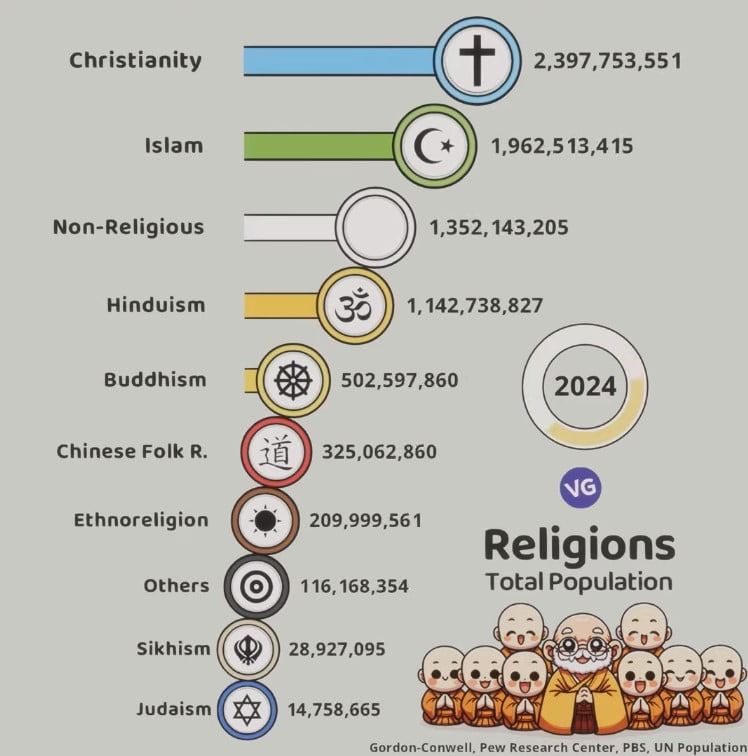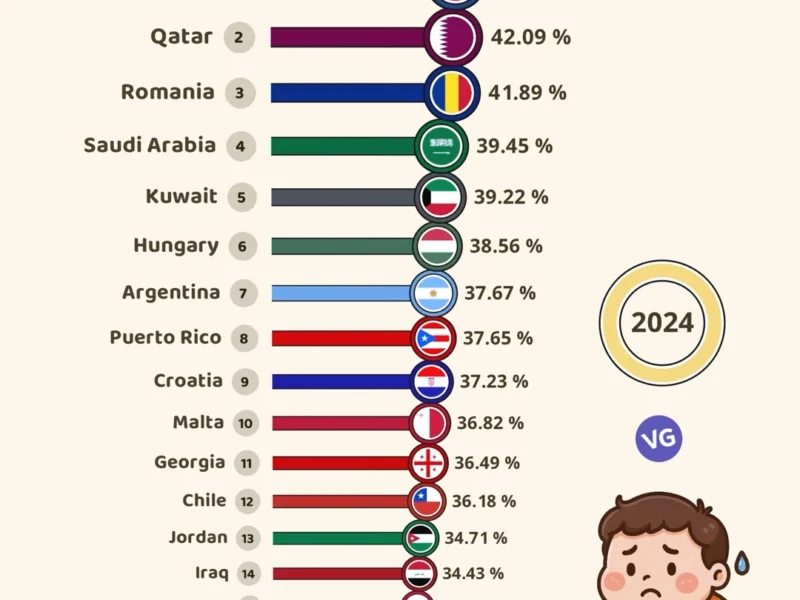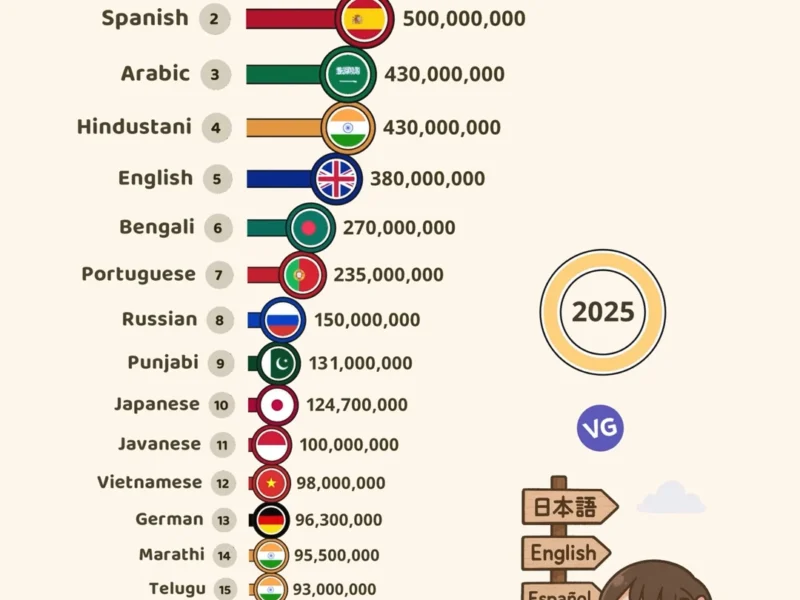Christianity is the top religion globally, with about 2.38 billion followers. This makes up around 31% of the world’s people12. Next, Islam has around 1.91 billion followers, which is about 24.9% of the world’s population1. Hinduism, an ancient Indian faith, comes third with 1.16 billion followers, or 15.2% of the world’s people1.
The Largest Religions in the World 2024
| Religion/Group | Symbol | Population |
|---|---|---|
| Christianity | ✝️ | 2,397,753,551 |
| Islam | ☪️ | 1,962,513,415 |
| Non-Religious | ⚪ | 1,352,143,205 |
| Hinduism | 🕉️ | 1,142,738,827 |
| Buddhism | ☸️ | 502,597,860 |
| Chinese Folk R. | 道 | 325,062,860 |
| Ethnoreligion | ☀️ | 209,999,561 |
| Others | ⊙ | 116,168,354 |
| Sikhism | ☬ | 28,927,095 |
| Judaism | ✡️ | 14,758,665 |
Buddhism has 507 million followers, which is 6.6% of the global population1. Folk religions have 430 million followers, making up 5.6% of the world1. Judaism has 14.6 million followers, which is just 0.2% of the global population1. About 1.19 billion people, or 15.6%, don’t follow any religion1.
Key Takeaways
- Christianity is the largest religion in the world, with an estimated 2.38 billion followers.
- Islam is the second-largest religion, with around 1.91 billion adherents.
- Hinduism is the third-largest religion, with 1.16 billion practitioners.
- The unaffiliated population, including atheists and agnostics, makes up 15.6% of the global population.
- The religious landscape is expected to undergo significant shifts in the coming decades, with the Muslim and Hindu populations projected to grow substantially.
Overview of World Religions
World Religions Population (2024)
Source: Gordon-Conwell, Pew Research Center, PBS, UN Population
.
Religion is a complex part of human life, filled with different beliefs and traditions. Around the world, there are about 4,000 to 4,300 religions, each with its own followers3. It’s hard to count how many people follow each religion because of how people identify themselves and the ways data is collected3.
Defining Religion
Religion is basically a set of beliefs and practices that shape how people see the world and live in it3. It’s a key source of moral and spiritual guidance for many, affecting their beliefs and actions.
Challenges in Counting Adherents
Figuring out how many people follow each religion is tricky3. Things like how religious someone is, whether kids are counted, and the data sources used can change the numbers a lot3. Also, it’s hard to count followers of religions that aren’t organized well3.
Still, researchers keep studying and sharing info on the world’s religions3. This helps us understand the diversity and changes in religious beliefs. Knowing about these helps us see how different beliefs shape our global community.
“Religions are diverse and ever-changing, reflecting the rich tapestry of human experiences and beliefs.”
Christianity – The Largest Religion
Christianity is the biggest religion, with over 2 billion followers. This makes it more than 30% of the world’s population4. It’s the top faith, with 2.38 billion followers worldwide, which is 31.1% of people globally56. The faith splits into Eastern and Western branches, including Catholicism, Protestantism, and Eastern Orthodoxy.
In many countries, most people are Christian. Vatican City and the Pitcairn Islands are fully Christian. Many other countries have over 93% of their people identifying as Christian5. By 2024, Christianity is expected to grow to about 2.4 billion, staying the biggest religion5.
“Christianity is a way of being in the world, a way of relating to God and to others based on the life and teachings of Jesus Christ.”
Even though Christianity is still the biggest, its share of the world’s population will drop slightly. This is because Islam and other faiths are growing6. Yet, Christianity’s large size and influence mean it will continue to be a major religious tradition.
Islam – The Fastest Growing Faith
Islam is the second-largest religion in the world, with about 1.91 billion followers. This makes up 24.9% of the world’s people7. It’s expected to grow faster than other big religions, possibly matching Christianity’s number of followers by 20507.
The number of Muslims is set to jump by 70% from 1.8 billion in 2015 to almost 3 billion by 20607. Muslims will grow faster in many regions, except in Latin America and the Caribbean7.
Muslim-Majority Countries
There are 50 countries where most people are Muslim8. Countries like the Maldives, Mauritania, and Saudi Arabia have populations that are all Muslim8. In India, the Muslim population is expected to rise from 14.9% in 2015 to 19.4% in 2060, reaching 333 million people7.
By 2060, Muslims will likely be the majority in Nigeria, making up 60.5% of the population7.
The growth of Islam is due to high birth rates, a young population, and the religion’s flexibility and strength8. Community and social support are key to Islam’s growth as the fastest-growing religion8.
Despite misconceptions and political issues, Islam continues to spread and make a mark worldwide87.
Hinduism – The Ancient Indian Tradition
Hinduism is the third-largest religion worldwide, with about 1.16 billion followers or 15.2% of the global population910. It started in the Indian subcontinent and is now practiced in Southeast Asia. This tradition is more than a religion; it’s a way of life or a family of religions9.
Most Hindus believe in a single god called “Brahman” but also honor many other deities9. They believe in the cycle of life, death, and rebirth, and in karma, the idea of cause and effect9. Their main goal is to achieve “moksha” or salvation through understanding the soul9.
Hinduism didn’t start with a single founder but came from many beliefs9. Its sacred texts, the Vedas, date back to around 1500 B.C9. Important gods and goddesses include Brahma, Vishnu, Shiva, and others9. Hindus respect all living things and see the cow as sacred, often eating vegetarian9.
In India, about 79.8% of people are Hindu11. Nepal also has a large Hindu population, with 81.3% of its people following this faith11. Worldwide, Hindus make up around 15% of the population, mostly living in the Asia-Pacific region10.

Hinduism has four main branches: Shaivism, Vaishnavism, Shaktism, and Smarta9. People worship in Mandirs and at home, offering prayers as a key part of their faith9. The caste system divides society into different groups, including Brahmins and “Untouchables.”9
“Hinduism is more than a religion. It is a culture, a way of life, a philosophy.”
Hinduism is the biggest religion in India and one of the oldest in the world91110. It greatly influences the spiritual and cultural life of the region and beyond91110..
Buddhism – Concentrated in Asia
Buddhism has about 507 million followers, making up 6.6% of the world’s people. Most of these followers live in the Asia-Pacific region12. In fact, 99% of all Buddhists call this area home12. About 73% of them live in countries where they are not the majority12. The average Buddhist is 34 years old12, showing it’s a young religion.
Countries with Buddhist Majorities
In Asia, some countries have more Buddhists than others. Cambodia leads with 97.9% of its people being Buddhist13. Thailand is close behind at 94.6%13. Burma (Myanmar) has 87.9% Buddhists13. Bhutan, Laos, Mongolia, and Sri Lanka also have big Buddhist populations14.
The Largest Religions in the World 2024
By 2024, the top religions will be: 1) Christianity (31.1% of the world), 2) Islam (24.9%), 3) Hinduism (15.2%), 4) Unaffiliated (15.6%), 5) Buddhism (6.6%), 6) Folk Religions (5.6%), and 7) Other Religions (1%)12. Even though it’s mainly found in Asia, Buddhism will still be the fifth-biggest religion worldwide.
Other Major Religions
There are many big religions besides Christianity, Islam, Hinduism, and Buddhism. For example, in China, people follow Confucianism and Taoism a lot15. In Guinea-Bissau and Haiti, about half the people believe in ethnic and indigenous religions15.
Folk Religions
Folk religions include beliefs from Africa, China, and Native American and Australian communities. They have about 430 million followers, which is 5.6% of the world’s people15. These beliefs are a big part of the culture in many places.
Judaism
Judaism is one of the smallest big religions, with around 14.6 million followers, or 0.2% of the world’s people15. It started in Judah (the Middle East) between the 6th and 5th centuries BCE. It’s the oldest of the Abrahamic faiths16.
“Judaism represents only 0.2% of the global population, consisting of about 16 million people.” –15
The Unaffiliated Population
The number of people who don’t follow any religion is growing in some parts of the world17. By 2040, it’s expected to hit over 1.2 billion people17. But, the share of unaffiliated people in the world will drop from 16% in 2010 to 13% by 205017.
Growth of Non-Religious Identities
In Europe and North America, more people are choosing not to follow any religion17. In the U.S., the “Nones” group has jumped from 16% in 2007 to 28% today18. This group includes atheists, agnostics, and those who say they have no religion. They now outnumber both Catholics and evangelical Protestants in the U.S18..
Nones often have a positive view of science and lean towards the Democratic party18. But, they’re less likely to vote or volunteer, which could affect community life18. Their growing numbers could change American society a lot18.
By 2050, the unaffiliated population will shift geographically17. The Asia-Pacific region will have less of them, dropping to 68%17. China will have 54% of the world’s unaffiliated people, with the U.S. and Japan having 8% and 6%, respectively17.
| Religious Group | Number of Adherents (in billions) | Percentage of World Population |
|---|---|---|
| Christians | 2.3 | 31.2% |
| Muslims | 1.8 | 24.1% |
| Hindus | 1.1 | 15.1% |
| Buddhists | 0.5 | 6.9% |
| Unaffiliated | 1.2 | 16% |
Even though the unaffiliated might make up less of the world’s population, their numbers will still grow in some areas17. This change, along with more diverse religious beliefs, will shape the future of religion19.
Geographic Shifts and Future Projections
The world’s religious scene is changing a lot, thanks to differences in birth rates, the number of young people, and how people switch religions20. By 2050, Islam might be as big as Christianity, making up 30% of the world’s people, just like Christianity21. Buddhists, Hindus, and Jews might have fewer followers, and fewer people might say they have no religion worldwide. Yet, in places like Europe and North America, more people might not follow any religion.
Youth Demographics
How old people are in different religions affects their growth. In 2010, 27% of the world’s people were under 1520. But, 34% of Muslims and 30% of Hindus were young, more than the 27% of Christians20. Young people in these religions will help them grow faster than the world’s population.
Religious Switching
People changing their religion will also change the religious mix. Christianity might lose 106 million followers, mostly to not having any religion21. But, the number of people with no religion will grow by 61 million, and Muslims, folk religions, and other faiths might gain followers too21.

| Religious Group | 2020 Share | 2050 Projected Share | 2070 Projected Share |
|---|---|---|---|
| Christianity | 64% | 47% | 39% |
| Islam | 24% | 30% | 31% |
| Unaffiliated | 16% | 13% | 13% |
| Other Religions | 5% | 10% | 17% |
“Christianity will gain three times more converts than any other world religion in the coming decades, but it will also lose 11 times more members than any other religion.”21
Conclusion
The world’s religious scene is changing, with big shifts in the size of major faiths22. Christianity is still the biggest religion, but Islam is expected to grow fast and almost match Christianity by 205023. Buddhists, Hindus, and Jews are seeing fewer people join, and the number of people without a religion is also dropping in some places22.
These changes come from things like differences in how many children people have, the age of the population, and people changing their religion2223. Christianity and Islam will keep being the biggest religions, but where they are found will change. Africa will become a key place for Christianity22.
This look at the world’s religions shows they will keep changing. This means big changes for how we live, work, and think together2223. As we all connect more, knowing about these changes and what they mean is key for leaders, religious figures, and everyone else.
FAQ
What are the largest religions in the world in 2024?
By 2024, the top religions are expected to be: 1) Christianity (31.1% of the world), 2) Islam (24.9%), 3) Hinduism (15.2%), 4) Unaffiliated (15.6%), 5) Buddhism (6.6%), 6) Folk Religions (5.6%), and 7) Other Religions (1%).
What is the largest religion in the world?
Christianity is the biggest religion, with about 2.38 billion followers. This makes up 31.1% of the world’s people.
What is the largest populated religion in the world?
Christianity is the most populous religion, with around 2.38 billion followers. This is 31.1% of the world’s population.
Which religion has the biggest population in the world?
Christianity has the largest population, with about 2.38 billion followers. This is 31.1% of the global population.
What is the first largest religion in the world?
Christianity is the first largest religion globally, with an estimated 2.38 billion followers. This is 31.1% of the world’s population.
What is the biggest religion in the world by population?
Christianity is the biggest by population, with around 2.38 billion followers. This is 31.1% of the global population.
Source Links
- Religion by Country 2024 – https://worldpopulationreview.com/country-rankings/religion-by-country
- The Future of World Religions: Population Growth Projections, 2010-2050 – https://www.pewresearch.org/religion/2015/04/02/religious-projections-2010-2050/
- World Religions Explained with Useful Charts: Hinduism, Buddhism, Judaism, Islam, Christianity & More – https://www.openculture.com/2024/06/world-religions-explained-with-useful-charts-hinduism-buddhism-judaism-islam-christianity-more.html
- Biggest Religion in the World, List of Top-10 – https://currentaffairs.adda247.com/biggest-religion-in-the-world/
- What Is the Most Widely Practiced Religion in the World? – https://www.britannica.com/story/what-is-the-most-widely-practiced-religion-in-the-world
- Major religious groups – https://en.wikipedia.org/wiki/Major_religious_groups
- Why Muslims are the world’s fastest-growing religious group – https://www.pewresearch.org/short-reads/2017/04/06/why-muslims-are-the-worlds-fastest-growing-religious-group/
- Why Islam Is the Fastest Growing Religion in the World? – https://bestdiplomats.org/why-islam-is-the-fastest-growing-religion/
- Hinduism – Origins, Facts & Beliefs | HISTORY – https://www.history.com/topics/religion/hinduism
- Hindus – https://www.pewresearch.org/religion/2012/12/18/global-religious-landscape-hindu/
- Hinduism | Origin, History, Beliefs, Gods, & Facts – https://www.britannica.com/topic/Hinduism
- The Global Religious Landscape – https://www.pewresearch.org/religion/2012/12/18/global-religious-landscape-exec/
- Buddhist Countries 2024 – https://worldpopulationreview.com/country-rankings/buddhist-countries
- Religion in Asia – https://en.wikipedia.org/wiki/Religion_in_Asia
- World Population by Religion: A Global Tapestry of Faith – Population Education – https://populationeducation.org/world-population-by-religion-a-global-tapestry-of-faith/
- List of religious populations – https://en.wikipedia.org/wiki/List_of_religious_populations
- Religiously Unaffiliated – https://www.pewresearch.org/religion/2015/04/02/religiously-unaffiliated/
- Religious ‘Nones’ are now the largest single group in the U.S. – https://www.npr.org/2024/01/24/1226371734/religious-nones-are-now-the-largest-single-group-in-the-u-s
- Religion: why faith is becoming more and more popular – https://www.theguardian.com/news/2018/aug/27/religion-why-is-faith-growing-and-what-happens-next
- What Is the Future of Religion in America? – https://www.pewtrusts.org/en/trust/archive/winter-2023/what-is-the-future-of-religion-in-america
- Here’s the Best Prediction Yet of How Christianity and Islam Will Change Worldwide by 2050 – https://www.christianitytoday.com/news/2015/april/heres-best-prediction-yet-christianity-islam-2050-pew.html
- Key Findings From the Global Religious Futures Project – https://www.pewresearch.org/religion/2022/12/21/key-findings-from-the-global-religious-futures-project/
- Growth of religion – https://en.wikipedia.org/wiki/Growth_of_religion



